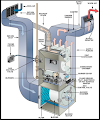Operation and Maintenance of Chillers
Part 1
 |
| maintenance chiller |
Introduction:
IntroductionChillers are a key component of air conditioning systems for large buildings. They produce cold water to remove heat from the air in the building. They also provide cooling for process loads such as file-server rooms and large medical imaging equipment. As with other types of air conditioning systems, most chillers extract heat from water by mechanically compressing a refrigerant.
Chillers are complex machines that are expensive to purchase and operate. A preventive and predictive maintenance program is the best protection for this valuable asset. Learn more about establishing a Best Practice O&M Program.
Chillers commonly use more energy than any other piece of equipment in large buildings. Maintaining
Chillers are complex machines that are expensive to purchase and operate. A preventive and predictive maintenance program is the best protection for this valuable asset. Learn more about establishing a Best Practice O&M Program.
Chillers commonly use more energy than any other piece of equipment in large buildings. Maintaining
<
Types of Chillers:
Mechanical Compression
During the compression cycle, the refrigerant passes through four major components within the chiller: the evaporator, the compressor, the condenser, and a flow-metering device such as an expansion valve. The evaporator is the low-temperature (cooling) side of the system and the condenser is the high- temperature (heat-rejection) side of the system.
 |
| The refrigeration cycle chiller |
Mechanical Compressor Chillers:
Mechanical compression chillers are classified by compressor type: reciprocating, rotary screw, centrifugal and frictionless centrifugal.
Reciprocating:
Similar to a car engine with multiple pistons, a crankshaft is turned by an electric motor, the pistons compress the gas, heating it in the process. The hot gas is discharged to the condenser instead of being exhausted out a tailpipe. The pistons have intake and exhaust valves that can be opened on demand to allow the piston to idle, which reduces the chiller capacity as the demand for chilled water is reduced. This unloading allows a single compressor to provide a range of capacities to better match the system load. This is more efficient than using a hot-gas bypass to provide the same capacity variation with all pistons working. Some units use both methods, unloading pistons to a minimum number, then using hot-gas bypass to further reduce capacity stably. Capacities range from 20 to 125 tons.
 |
| Reciprocating compressor chiller |
Rotary Screw:
The screw or helical compressor has two mating helically grooved rotors in a stationary housing. As the helical rotors rotate, the gas is compressed by direct volume reduction between the two rotors. Capacity is controlled by a sliding inlet valve or variable-speed drive (VSD) on the motor.
Capacities range from 20 to 450 tons
The centrifugal compressor operates much like a centrifugal water pump, with an impeller compressing the refrigerant. Centrifugal chillers provide high cooling capacity with a compact design. They can be equipped with both inlet vanes and variable-speed drives to regulate control chilled water capacity control. Capacities are 150 tons and up.
 |
| Centrifugal compressor |
Frictionless Centrifugal:
This highly energy-efficient design employs magnetic bearing technology. The compressor requires no lubricant and has a variable-speed DC motor with direct-drive for the centrifugal compressor. Capacities range from 60 to 300 tons.
 |
| Turbocor© frictionless centrifugal compressor |
Absorption Chillers
Absorption chillers use a heat source such as natural gas or district steam to create a refrigeration cycle that does not use mechanical compression. Because there are few absorption machines in the Northwest U.S., this document covers only mechanical-compression chillers. You can learn more about absorption chillers at the Energy Solutions Center.
Absorption Chillers
Absorption chillers use a heat source such as natural gas or district steam to create a refrigeration cycle that does not use mechanical compression. Because there are few absorption machines in the Northwest U.S., this document covers only mechanical-compression chillers. You can learn more about absorption chillers at the Energy Solutions Center
You can find in the blog of air-conditioning all the news and information in the field of cold and climatisaion in club chiller control
https://www.masabihaddoja.com/
airconditioner-auto
http://adf.ly/1OJam9
clubclimfroid.blogspot
http://adf.ly/1OJazt
clubchillercontrol.blogspot
http://adf.ly/1OJb4w
youtubeclimafroid.blogspot
http://adf.ly/1OJbKo
youtube.com/user/abobahaaeddine
http://adf.ly/1OJbQM
Absorption chillers use a heat source such as natural gas or district steam to create a refrigeration cycle that does not use mechanical compression. Because there are few absorption machines in the Northwest U.S., this document covers only mechanical-compression chillers. You can learn more about absorption chillers at the Energy Solutions Center
You can find in the blog of air-conditioning all the news and information in the field of cold and climatisaion in club chiller control
https://www.masabihaddoja.com/
airconditioner-auto
http://adf.ly/1OJam9
clubclimfroid.blogspot
http://adf.ly/1OJazt
clubchillercontrol.blogspot
http://adf.ly/1OJb4w
youtubeclimafroid.blogspot
http://adf.ly/1OJbKo
youtube.com/user/abobahaaeddine
http://adf.ly/1OJbQM
abo bahaa eddine.












0 Comments